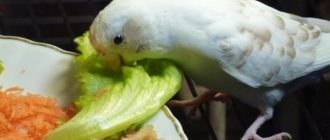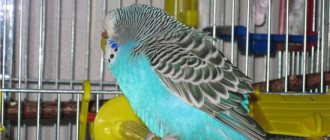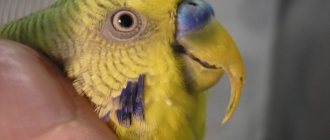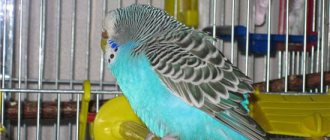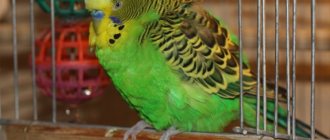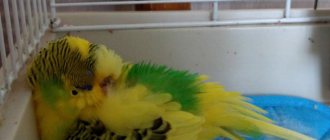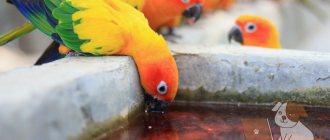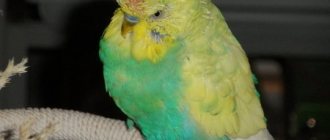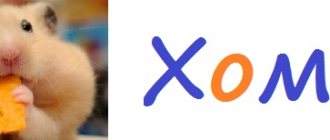It is normal for birds to clean their plumage frequently. This is how they maintain the purity and balance of parasites on the body. But if a budgie is constantly itching, this indicates the presence of various diseases. Unfortunately, there are many reasons for this behavior, and their manifestations can be similar. Therefore, it is worth analyzing why the parrot itches and identifying all possible diseases that cause such symptoms.
Natural causes
Don’t panic right away if the wavy fish suddenly starts cleaning itself more often. There are a number of harmless reasons for this.
Shedding
When healthy, birds have dense plumage, which allows them to control heat exchange. To ensure that it always looks good and performs its functions, most birds molt periodically. This is a natural process that does not require intervention from the owner.
In budgerigars, the first molt occurs at the age of 3 months. This period usually lasts about a month. But the first moult can last 2 months.
Birds normally shed a small amount of down each day, and sometimes feathers fall out. During molting, their number increases significantly. First the fluff falls off. This process is highly organized, as evidenced by the pairwise loss of tail and flight feathers. It is worth remembering that the process is accompanied by a rapid metabolism, so the pet needs a properly balanced diet and vitamin supplements.
During this period, the parrot rubs its head or other parts of its body against a perch or cage. He loves to swim, so he needs to be provided with plenty of water and changed regularly.
Down and feathers fall out gradually, but a new covering immediately begins to grow in their place. During normal molting, no bald patches should be visible on the body. If a naked body is visible, there may be a different reason. It is worth observing the behavior of your pet at this time; if he does not just comb out the feathers, but pulls them out, he suffers from a lack of vitamins or an excess of parasites. Both cases require treatment.
Hygiene
Birds need to constantly maintain cleanliness and tidiness. If a fluff is knocked out, the bird strives to immediately put it back, so it itches with its beak and runs its head along its back.
Parrots carry out the procedure of cleaning and laying their cover regularly every day. It is accompanied by a slight loss of small fluff. Only a small amount accumulates at the bottom of the cell over a few days. At the same time, the parrot does not itch all the time, but only for a short time. If it shakes and itches frequently, this indicates a problem.
What does the color of the litter mean?
You can learn a lot by looking at the color of the droppings, since some diseases have their own specific color.
| Litter color | Characteristic disease |
| Yellow or bright green | Liver problems caused by parasites or poisoning. This can also serve as a signal about the presence of poisoning in the pet’s body. |
| White with a gray tint | This indicates that the bird is not doing well with its pancreas. It is better to exclude fatty foods. |
| Black droppings and a lot of liquid | The nervous system and gastrointestinal tract are affected. |
| A huge amount of white tint | Presence of arthritis and kidney failure. |
| Transparent | You should urgently treat your pet, as this is a very alarming signal. Never let him go hungry. Feed soft food with a syringe. Food is placed in the corner of the beak every hour, 0.5 ml. |
| Red | You should experiment a little with this litter. Take hydrogen peroxide and drop it on the droppings, if it hisses, it means there is blood in it. Give 1 drop of Dicynon in the beak and urgently take it to the doctor. If such a reaction does not occur, then remember that you did not accidentally feed your pet beets, since they can easily turn the droppings burgundy-red. |
Fungal diseases
Bird skin consists of dermis and epidermis. The dermis contains hair follicles and muscles. The epidermis consists of horny scales and a germ layer.
The epidermis is quite thin, dry, and does not contain sweat glands. Therefore, birds often develop various fungal diseases. This happens mainly due to poor nutrition or hygiene.
Skin dermatitis
Dermatitis is an acute inflammatory lesion of the skin. Accompanied by peeling and redness of the affected area of the skin. Easily detachable grey-yellow or brown crusts form in the affected areas.
The disease is aggravated by the fact that the budgie scratches the affected areas. Because of this, bleeding occurs. The fluff on the damaged areas sticks together from blood and secretions. At the first symptoms of skin dermatitis, you should consult a veterinarian.
Malassezia
This disease is caused by a yeast fungus of the genus Malessezia. This is one of the most common fungal infections among birds. It develops as a result of weakened immunity and poor nutrition. These fungi normally live on the bird’s body, and after the immune system is weakened, they begin to actively multiply, which leads to Malassezia.
It is characterized by severe itching, which is why the budgerigar often itches throughout the day. This leads to severe irritation of the skin, severe skin erosion, and local baldness.
Candidiasis
Candidiasis is caused by yeast fungi of the genus Candida. They are also pathogenic and are normally found on the skin. When the immune system is weakened, candida actively multiply and cause the disease candidiasis.
The parrot often itches and rubs its butt or other parts of the body only if the skin is affected by candidiasis. In this case, severe itching appears, which is accompanied by a white coating.
Video “What to do if a bird is itching?”
You can find out even more details about why a parrot itches and what needs to be done from the video below.
Sorry, there are no surveys available at this time.
Was this article helpful?
Thank you for your opinion!
The article was useful. Please share the information with your friends.
Yes
No
X
Please write what is wrong and leave recommendations on the article
Cancel reply
Rate the benefit of the article: Rate the author ( 3 votes, average: 4.67 out of 5)
Discuss the article:
Diseases that cause the most common scabies
How often the parrot itches and shakes its wings depends on the degree of development of the fungus. And if this illness leaves the pet alone for a while, then others will not give him freedom for a minute. This problem includes parasites.
Parasites
The most common parasites that cause persistent scabies are the following:
- down-eaters;
- lice;
- scabies mite;
- red tick
The most dangerous from this list are down-eaters. These are small insects of the order lice and lice. They settle on the bird's skin and plumage. They feed on down, scales of the upper layer of the dermis, feather barbs and blood that oozes from damaged surfaces. Most often they settle on the head, neck and armpits. Therefore, in the presence of these parasites, these areas are the first to begin to go bald.
Lice belong to the same order as fluff eaters. The symptoms and treatment are the same, but lice do not cause as much damage to your pet's feathers and down.
The scabies mite lives on the paws or feathers of an animal. In the first case, he will not be able to move freely around the cage and will constantly scratch between his fingers. In the second case, you will constantly itch, the skin will turn red, and the fluff will begin to fall out.
Red mites start in cages where hygiene is not maintained. These parasites are nocturnal. They multiply quickly and only become noticeable in large numbers. Unlike other parasites, they live on pet household items. When infected, in addition to scabies and baldness, growths appear on the affected areas, the beak becomes softer, and eventually collapses.
If the parrot often scratches its head on the perch and shakes itself, it is worth examining it with a magnifying glass. If the cause is parasites, a magnifying glass will help you see them
Symptoms
How exactly does a bird behave when a problem like this arises?
Feather loss
- The parrot is indifferent to everything that happens around him. Feathers are absent mostly on the belly, chest and wings. In some, most severe cases, plumage disappears from the entire surface of the body, except the head.
- Plucked feathers look frayed : they are bitten and torn. At first, the parrot pulls out feathers while grooming itself, and then more and more often and for a longer period of time.
- The bird also pulls out “live” and young feathers , and then bleeding occurs. Sometimes the pet touches the skin and injures itself.
Scratching the cloaca
The cloaca is an expanded part of the hindgut. It combines the ducts of the excretory and reproductive systems. Often, budgies clean not the cloaca itself, but the fluff around it. But if your pet often itches its butt, this is a sign of possible diseases:
- problems with the gastrointestinal tract;
- helminthic infestations;
- cloacite;
- fungal infections;
- stress;
- ticks.
If you have problems with the gastrointestinal tract, you will also experience typical symptoms of poisoning: vomiting, loose stools, poor appetite. The latter can also accompany infection with worms. A characteristic sign of cloacitis is swelling and stickiness in the cloaca area. Fungal diseases and mites usually affect all the skin, and not just one area, so the parrot itches and pulls out feathers and fluff. It is not difficult to distinguish them, you just need to be more observant and attentive to your pet.
Parasite infestation
If a budgerigar intensively loses feathers, constantly itches, pulls out feathers, or has bald patches or bald spots on its body, most likely the bird is infected with ectoparasites - scabies mites, feather eaters.
Carefully inspect your pet for fallen feathers. On them you can see traces of the vital activity of parasites. Place a white cloth and a sheet of paper on the bottom of the cage. If small black, gray, or red dots appear, the parrot is infected with a mite.
To prevent the bird from losing its plumage, if the body begins to itch severely, it must be treated immediately using preparations for general and local use (ointments, suspensions, liniments).
The parrot's feathers are falling out
Other reasons
Constant scratching can be associated not only with blemishes. Other causes are just as dangerous and can even lead to the death of the animal.
Stress and loneliness
Many owners forget that pets require attention. Wavys and lovebirds need a pair. And without it, they often fall into a depressive state, which is why they begin to pull out feathers, scratch themselves frequently, and lose their appetite.
To exclude this option, just buy a pair of wavy ones or hang a mirror in the cage. But don’t immediately attribute this behavior to stress and loneliness. First, you need to check your pet for other diseases. You also need to monitor him to notice other symptoms and make a more accurate diagnosis.
Lack of vitamins
This often happens in winter or with poor nutrition. For the normal functioning of a pet, it is necessary to carefully plan its diet, it must be balanced and contain all the necessary minerals. It is especially worth observing the behavior of the animal in winter. With a lack of vitamins, severe loss of feathers and down, as well as a large amount of dandruff, is observed.
Wrong diet
An unbalanced diet is not only a lack of vitamins. The presence of prohibited foods in the diet and the lack of necessary ones will lead to various health problems, including skin problems, due to which the pet will constantly itch.
Dry air
Many parrot owners make this mistake. In winter, when the apartment begins to be heated, the air becomes drier. This causes the bird's skin to peel and dry out, causing it to feel uncomfortable and itch constantly.
If there is no hygrometer in the room, then you should rely on sensations and use a humidifier in very dry air. The cage should be kept away from heating systems.
Incorrect lighting
In their natural environment, birds receive a lot of sunlight. Therefore, at home you need to try to meet the bird’s need for light. This can be done using a UV lamp. But it is worth remembering that it must be installed at the correct distance, because too bright a light will frighten the pet and lead to stress.
Gastrointestinal disorder
Unusual behavior of the bird indicates a disruption of the gastrointestinal tract. The causes of malfunction in the bird’s body include improper maintenance and feeding of the parrot, food poisoning or toxic fumes (cigarette smoke, fumes from paint, varnish, perfume). Gastrointestinal upset causes diarrhea. Liquid droppings cause discomfort and discomfort. Irritation in the cloaca area leads to the parrot scratching its butt on the perch.
Associated symptoms include:
- anxious behavior;
- plucking feathers in the cloaca area;
- liquid droppings with discoloration;
- vomit;
- refusal of food and water.
Methods to combat the disease
There are many reasons that can lead to scratching and pulling out feathers. Their additional symptoms and methods of control are discussed in each of the paragraphs.
The main rule is observation. Attention to your pet will help you notice additional symptoms and accurately determine the disease, and, therefore, the method of combating it.
Previous
UsefulHow and how much parrots sleep, sleep problems
Next
Useful Aversectin ointment and its use for parrots
Violation of living conditions and feeding standards
Insufficient content of vitamins, essential amino acids (cystine, lysine, methionine), and minerals in the diet is one of the most common self-plucking problems. If your cockatiel is itching and plucking feathers, one of the reasons may be a lack of protein in the food. Parrots simply need protein food. The amount of protein required depends on the type of parrot.
Self-plucking can be caused not only by an unbalanced, poor diet, but also by a violation of the feeding regime.
Dry air in apartments, especially during the heating season, cramped cages, physical inactivity, and lack of toys adversely affect the condition of feathers in birds. Parrots have dry skin and no sebaceous or sweat glands, with the exception of the coccygeal gland. At the same time, the coccygeal gland is absent in grays, macaws, and Amazons.

